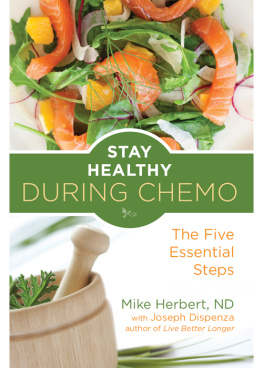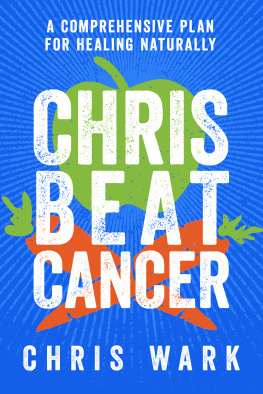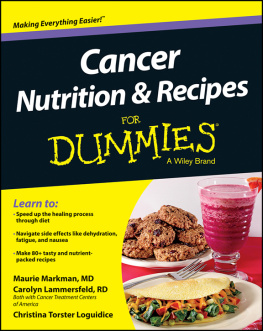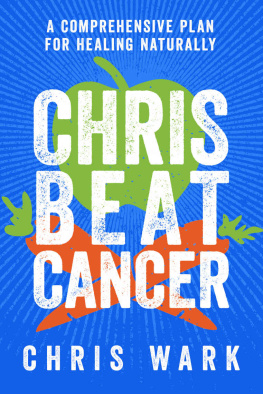
This edition first published in 2015 by Conari Press
an imprint of Red Wheel/Weiser, LLC
With offices at:
65 Parker Street, Suite 7
Newburyport, MA 01950
www.redwheelweiser.com
Sign up for our newsletter and special offers by going to www.redwheelweiser.com/newsletter.
Copyright 2012 by Mike Herbert
All rights reserved. No part of this publication may be reproduced or transmitted in any form or by any means, electronic or mechanical, including photocopying, recording, or by any information storage and retrieval system, without permission in writing from Red Wheel/Weiser, LLC. Reviewers may quote brief passages. Originally published in 2012 by Mike Herbert as The Chemotherapy Diet, ISBN: 978-1475171235.
ISBN: 978-1-57324-675-0
Library of Congress Cataloging-in-Publication Data available upon request
Cover design by Jim Warner
Interior Design by
Printed in the United States of America
MG
10 9 8 7 6 5 4 3 2 1
www.redwheelweiser.com
www.redwheelweiser.com/newsletter
DEDICATION
This book is dedicated to courageous cancer patients everywhereand their heroic caregivers.
There is hope.
Contents
PART ONE
Chemotherapy Is Only Part of the Healing Process
PART TWO
The 5-Step Chemotherapy Diet Program
PART THREE
Recipes: Eating Healthy
PART FOUR
Beyond Chemotherapy
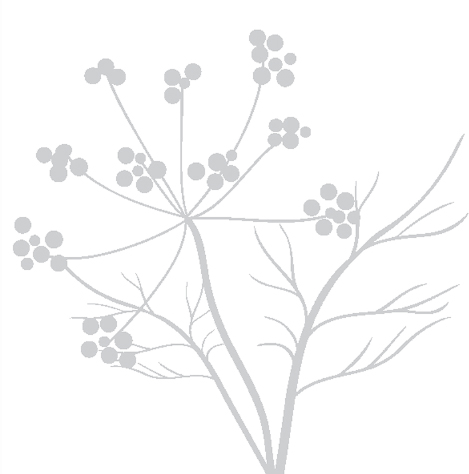
Your present circumstances don't determine where you can go; they merely determine where you start.
Nido Qubein
Introduction
I am writing this book because when I faced a cancer crisis of my own, I could not find a book that would give me solid, reliable information fast enough.
Here is what happened. Out of the blue, my partner, who seemed to be enjoying perfect health up to then, was diagnosed with Stage IV Non-Hodgkin's Lymphoma. The disease was both virulent and aggressive, advancing daily throughout his body's lymphatic system and threatening to attack his internal organs.
After we got over the shock of an impending death sentence, we began to sort out what needed to be done. Both of us are confirmed natural healing advocates: I am a naturopathic doctor; he has written a book and scores of articles on alternative healing methods. By temperament and by training, we leaned toward seeking a cancer cure outside what is considered conventional medical procedure. But, mainly because of the cancer's rapid progress, we opted for traditional cancer treatment under the direction of a traditional oncologist.
We understood that choosing conventional treatment over some of the new alternative, complementary, and integrative approaches probably meant chemotherapy and radiation, maybe even surgery. These are the standard weapons used by allopathic (conventional Western) oncologists in the war against cancer.
We also suspected that this arsenal of medical chemicals, especially in the case of chemotherapy, probably would be effective in attacking the cancer, but might not be helpful beyond that. I knew that chemotherapy is designed to kill cells in the body and will stop rapidly dividing cells from multiplying. That is what it will do. What chemo will not do is make a person healthy.
Overnight, I became both a full-time caregiver and nutritional researcher. I was highly motivated to find out how to help my partner stay alive. Because the cancer was advancing rapidly, I closed down my practice and put myself back in graduate school, with myself as the only studentas if I was working on another doctoral degree in naturopathy, this time with a specialization in staying healthy during chemotherapy.
So, we entered traditional cancer treatmentsometimes referred to as the cancer treatment systembut with our eyes wide open, looking for every opportunity to balance the destructive work of the chemo chemicals with constructive, life-boosting foods and supplements.
As my research progressed, I began introducing natural healing practices into my partner's personal anti-cancer program. The first order of business was to radically alter what he was eating. He had always been a careful eater, but the new situation called for a thorough scrutiny of the foods that had been his regular fare up to that point.
If the first big area of concern was what he was eating, the second, and just as important, was what he was takingthat is, supplements. My research was showing that the most highly trusted sources were endorsing the use of supplements during chemo, and in therapeutic doses, many times the daily dosage for a healthy person.
Six chemo treatments were prescribed by the doctor. They would be administered three weeks apart, allowing just enough time to recover from one session before undertaking the next. Again, because of the rapid spread of the disease, chemo would begin three days after the initial diagnosis.
Along with conventional treatment, which included not only the chemo drugs but also other pharmaceuticals for various side ailments before, during, and after the actual chemo days, we embarked on a strict regimen of a newly formulated diet, supplemented by vitamins, minerals, and herbs.
Detoxification was also a pressing issue because the chemo needed to leave the body as quickly as possible and take the dead cancer cells with it. I recommended that my partner take detox baths and coffee enemas, based on ideas put forth by highly respected natural healers who were using them with cancer patients.
Added to all this was an exercise programa daily walk that began as a tentative stroll around the block and progressed to, in a couple of weeks, a nature hike of nearly two miles. Oddly, perhaps, I did not have to push this exercise on my partner. He did it on his own, at a time of the day when he had the energy, because, with the rich nutrients he was taking in, he felt up to walking and felt really good afterwards.
Several weeks went by, with some good days and some bad daysall bravely borne by my partner with anticipation of a bright light at the end of the dark tunnel of treatments. Meanwhile, I continued my investigation into how a person can stay healthy throughout conventional cancer therapy, using the power of nature and the body's own healing capabilities as allies.
During all this time, my partner suffered no nausea or vomiting, and rarely had diarrhea or constipation. There was no indigestion, no heartburn, no dehydration. These and other common side effects of chemo relating to food and drink seemed to be taken care of by a proper diet, one that allowed for optimum digestion and assimilation.
Sometimes, if he was up to it, we listened to informational tapes and watched videos together, comparing notes afterwards. In time, I had compiled several file folders bulging with data on the role of nutrition and supplementation in the treatment of cancer from the latest and most trustworthy sources. Study after study repeated the same encouraging message: keep a positive attitude, detox, eat right, supplement the diet, exercise.
A PET/CT scan after the third chemo treatment showed that no cancer was visible in my partner's body. Naturally, this was cause for optimism. But, as the oncologist kept reminding us, a scan only shows what is visible. To get at what was happening at the microscopic level, we would need more blood work, more probing, more examinationsand more chemotherapy.
But after the fifth round of chemo (of the prescribed six), the lab results were thought to be so good that a final round of the chemicals was deemed unnecessary. Choosing to stop chemo varied from the oncologist's original conservative prescription, but the chemo seemed to be doing more damage at this point than the cancer had done; although there were few physical side effects present, my partner's mental abilities seemed to be increasingly compromised. The oncologist agreed with us to shorten the chemotherapy treatment, or at least he did not insist on one more blast of chemo.
Next page
